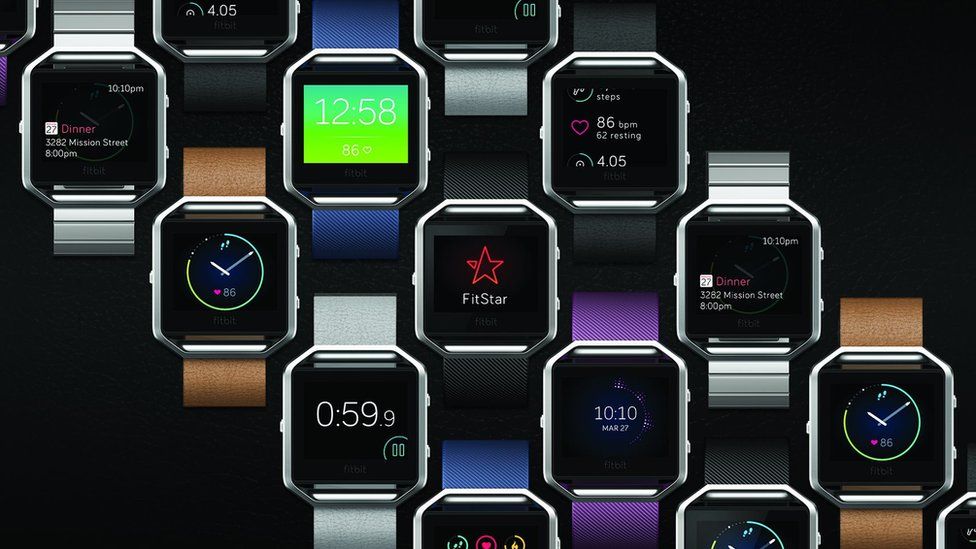CES 2016: Fitbit Blaze smartwatch sends shares into dive
- Published

Fitbit's shares plunged following the announcement of its first colour smartwatch at the CES tech show.
The San Francisco-based company's stock fell more than 18%.
That suggests investors were disappointed with its decision to take on more capable Android and Apple-powered watches by selling its own device at a cheaper price.
Huawei, Misfit and Withings were among other big brands to unveil new wearables at the Las Vegas show.
Huawei expanded its Android Wear-powered smartwatch family with two models targeted at women.
Misfit announced a small activity-monitoring metal cylinder that is designed to be worn alongside bracelets and watchbands.
And Withings revealed a budget-priced tracker with an e-ink display.
Fitbit may be the bestselling fitness tracker brand, but company-watchers have doubts about its move into new territory.
"It's an aggressive and risky move," commented Daniel Ives from FBR Research.
"Fitbit has been massively successful in its own niche of the market, and the jury's out on whether the Blaze smartwatch is the right move at the right time."
About 91.5 million smartwatches, sports watches and activity-tracking wristbands were shipped in 2015, according to tech research firm Gartner.
It predicts that number will rise to 116.4 million units this year.
Fitstar tie-up
The Blaze watch provides notification alerts and can control what music a wirelessly-connected smartphone is playing via its colour touchscreen.
But like the rest of the firm's line-up, its focus is on health.
It can track sleep and workouts, automatically detecting what activity the user is engaged in from a range of exercises including tennis, football, basketball, treadmill running and Zumba.
It can also display on-screen workouts from Fitstar - a popular app - measure the user's heart rate and last up to five days between charges.
Unlike the firm's earlier Surge "super watch" it does not include its own GPS chip, so it must be paired with a phone to provide location-tracking data.
The central module costs $200 (£136) and can be swapped between a range of octagonal-shaped wristbands and straps that will cost between $30 and $130.
That makes it cheaper than the Apple Watch and devices running Google's Android Wear operating system.
The question is whether consumers will prefer to spend more to have the ability to tap into a large library of third-party apps.
"When you compare Fitbit to companies like Apple and Google it doesn't have the software talent to offer a fully-fledged mobile operating system," commented Daniel Matte from the Canalys consultancy.
"But at this price point it's pretty good value and is a natural next step for the firm."
But another analyst questioned the wisdom of entering the smartwatch sector.
"If I were an investor, I would ask 'what competitive advantage does Fitbit bring to the table?' and 'do we want to compete against Apple, Google and Samsung?'" said Julie Ask from Forrester Research.
"Having an app ecosystem, and ease of use is so important in this sector."
Minimalist Misfit
Misfit's Ray represents the opposite approach.
The aluminium pod can be worn on a strap or around the neck, and runs for up to six months at a time using replaceable batteries.
It does not feature a screen, but has an LED that flashes different colours and can also vibrate to provide alerts.
Its only sensor is an accelerometer, which is used to track activities and sleep.
The firm said the $99 device was deliberately designed to have a "minimalist" appearance so it could be worn alongside other accessories.
"Misfit was one of the first companies to embrace more fashionable wearables, and the Ray is another positive step in delivering an attractive device with broader appeal to women than the ubiquitous black plastic fitness band," commented Ben Wood from the CCS Insight consultancy.
Misfit was recently taken over by Fossil, which makes watches and jewellery under brands that include Diesel, Michael Kors, Emporio Armani, and Relic.
Its technology is now set to be incorporated into a wide range of fashion-focused wearables planned by its parent company.
E-ink screen
French firm Withings' latest device is even cheaper and lasts longer.
The Withings Go costs $70 - or £49 in the UK - and uses an e-ink screen to maximise its battery life.
The firm says a replaceable button cell should last eight months at a time.
It connects to smartphone app and can track swimming among other activities thanks to being water resistant.
'Shiny and blingy'
Huawei said its new watches were designed for "women who sparkle and shine".
The Jewel and Elegant editions both have 44mm-diameter (1.7in) circular screens - which are bigger than the 42mm original design - and are encased in stainless steel plated with rose gold.
The $599 Jewel version features 68 Swarovski crystals dotted around its case, while the $499 Elegant one has a "knurled" pattern instead.
In other respects the wristwear is similar to the original models launched in 2015 apart from the addition of 10 new digital watch faces, which the firm says offer a more "feminine design".
Mr Wood suggested the Chinese firm should have taken the opportunity to add other software features.
"Pink, shiny and blingy is a long way from women's technology emancipation," he said.
"A 'wearable for women' should offer a lot more than a few Swarovski gems and a shiny finish - the implication is that women don't care about functions which is naive."
Huawei follows Motorola, which released a female-targeted version of its Android Wear Moto 360 watch in September.
"This is an area where the wearables market is moving," remarked Mr Ives.
"But a bigger issue is that there needs to be a killer app outside of health.
"The question remains which of the players will be able to take the market into a new direction."
Read more of our CES articles and follow the BBC team covering the show on Twitter.
- Published5 January 2016
- Published5 January 2016